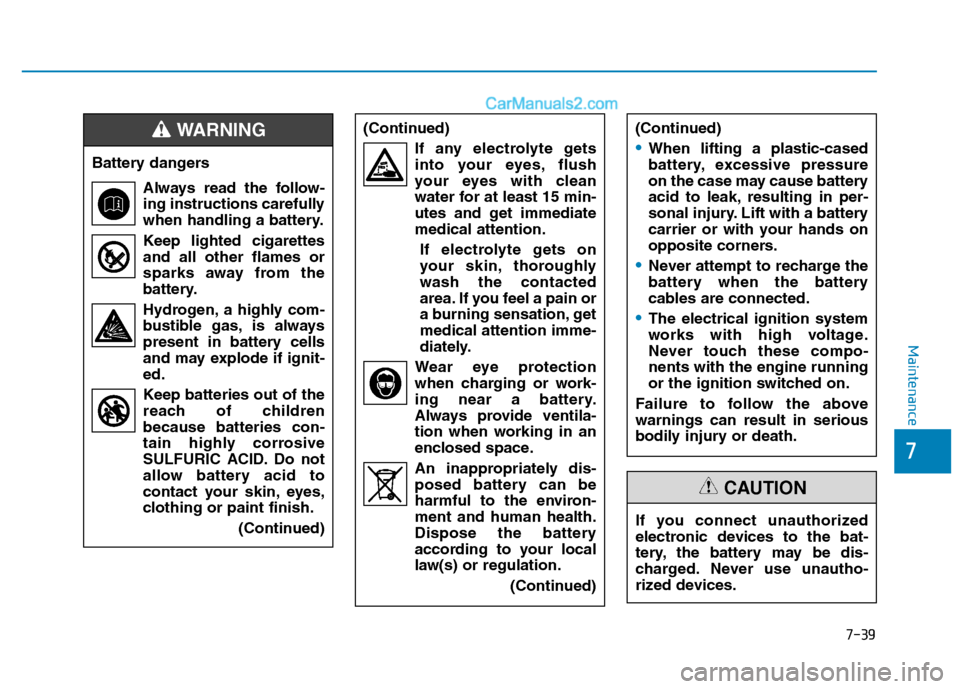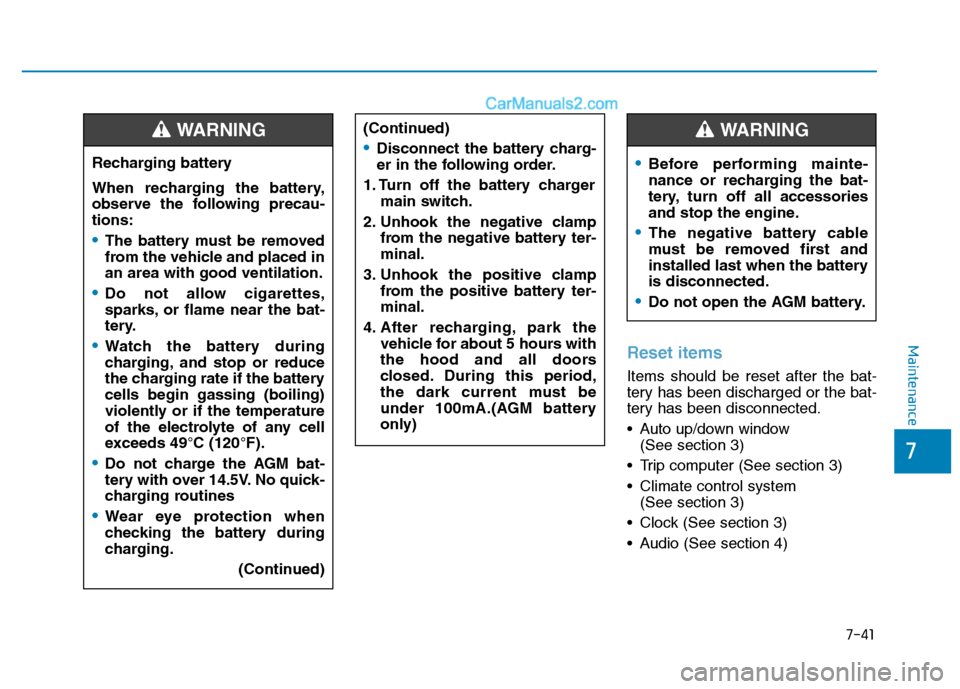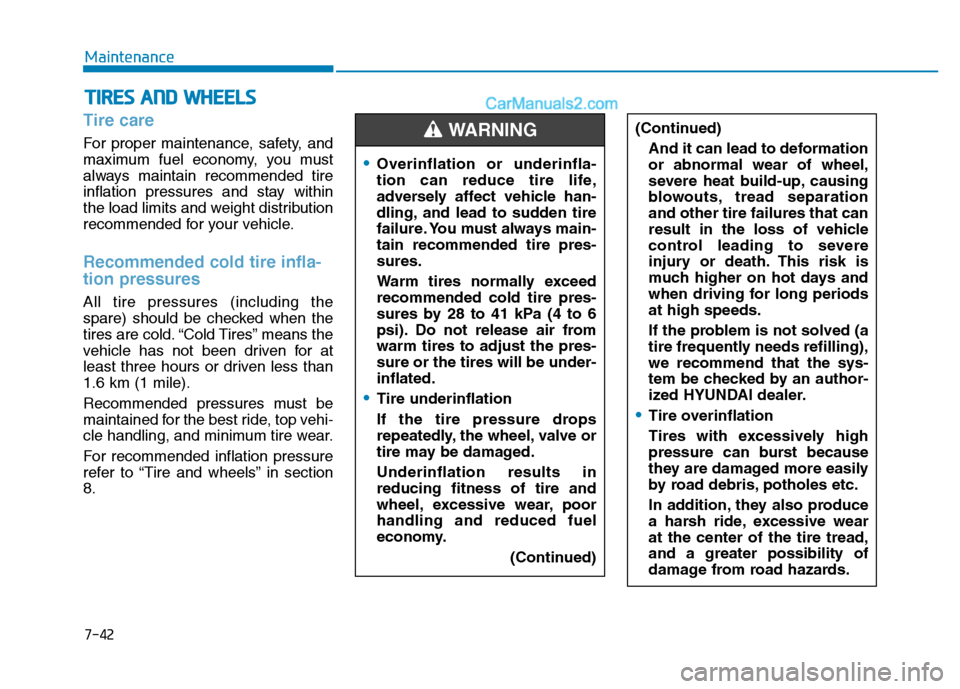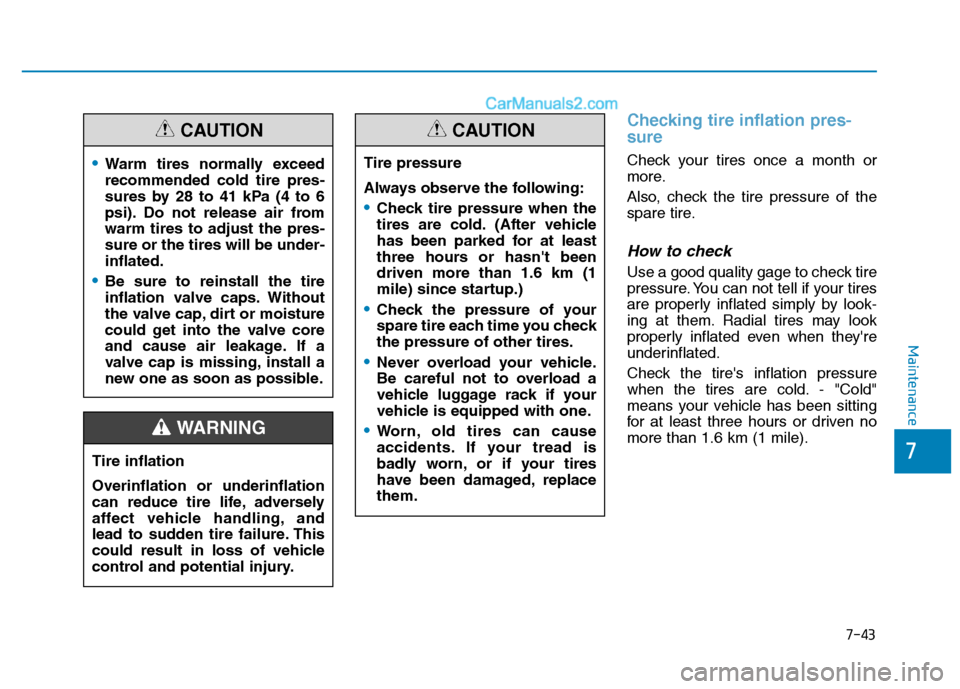Page 399 of 473
7-36
Maintenance
2.Compress the clip and slide theblade assembly downward.
3.Lift it off the arm.
4.Install the blade assembly in the reverse order of removal.
■■ Type B
1.Raise the wiper arm.
2.Turn the wiper blade clip. Then liftup the blade clip.
3.Push the clip (1) and push up the wiper arm (2).
Do not allow the wiper arm to
fall against the windshield,
since it may chip or crack thewindshield.
CAUTION
OEU074069
OEU074068
OEU074066
OEU074065
OEU074063
Page 400 of 473
7-37
7
Maintenance
4.Push down the wiper arm (3) andinstall the new blade assembly in
the reverse order of removal.
5.Return the wiper arm on the wind
For best battery service
Main battery
The main battery is located in the
battery case in the driver's footwell. - To remove the battery, removethe floor mat and loosen 4 bolts
of the service cover.
OEU074024
BB AA TTTTEERR YY
Objects cannot enter the dri-
ver's footwell. Fit the floor mat
securely as specified in order
to ensure sufficient clearance
for the pedals. Do not useloose floor mats.
Be careful not to damage the
battery sensor when you han-
dle the main battery.
WARNING
OEU074064
Battery sensor
Page 401 of 473

7-38
Maintenance
Auxiliary battery (VAN/Truck)
The auxiliary battery is located in
engine room. (if equipped)
Keep the battery securely mount-ed.
Keep the battery top clean and dry.
Keep the terminals and connec- tions clean, tight, and coated with
petroleum jelly or terminal grease.
Rinse any spilled electrolyte from the battery immediately with a
solution of water and baking soda. Basically equipped battery is
maintenance free type. If your
vehicle is equipped with the bat-
tery marked with LOWER and
UPPER on the side, you can check
the electrolyte level. The elec-
trolyte level should be between
LOWER and UPPER. If the elec-
trolyte level is low, it needs to add
distilled (demineralized) water
(Never add sulfuric acid or other
electrolyte). When refill, be careful
not to splash the battery and adja-
cent components. And do not
overfill the battery cells. It can
cause corrosion on other parts.After then ensure that tighten the
cell caps. We recommend that you
contact an authorized HYUNDAI
dealer.
NOTICE
Do not open the AGM battery.
WARNING
OEU074025
When replacing the battery,
we recommend that you use
parts replacement from an
authorized HYUNDAI dealer.
There is a vent hose for
degasing. You must check the
connection for venting when
you change the battery.
CAUTION
OEU075075
Battery sensor
Vent hose
Page 402 of 473

7-39
7
Maintenance
(Continued)If any electrolyte getsinto your eyes, flush
your eyes with clean
water for at least 15 min-
utes and get immediatemedical attention.
If electrolyte gets on
your skin, thoroughlywash the contacted
area. If you feel a pain or
a burning sensation, getmedical attention imme-
diately.
Wear eye protection when charging or work-
ing near a battery.
Always provide ventila-
tion when working in an
enclosed space.
An inappropriately dis- posed battery can be
harmful to the environ-
ment and human health.
Dispose the battery
according to your local
law(s) or regulation.
(Continued)(Continued)
When lifting a plastic-cased
battery, excessive pressure
on the case may cause battery
acid to leak, resulting in per-
sonal injury. Lift with a battery
carrier or with your hands on
opposite corners.
Never attempt to recharge the
battery when the battery
cables are connected.
The electrical ignition system
works with high voltage.
Never touch these compo-nents with the engine running
or the ignition switched on.
Failure to follow the abovewarnings can result in serious
bodily injury or death.
If you connect unauthorized
electronic devices to the bat-
tery, the battery may be dis-
charged. Never use unautho-
rized devices.
CAUTION
Battery dangers
Always read the follow-
ing instructions carefully
when handling a battery.
Keep lighted cigarettes and all other flames or
sparks away from the
battery.
Hydrogen, a highly com- bustible gas, is always
present in battery cells
and may explode if ignit-ed.
Keep batteries out of the reach of children because batteries con-
tain highly corrosive
SULFURIC ACID. Do not
allow battery acid to
contact your skin, eyes,
clothing or paint finish.
(Continued)
WARNING
Page 403 of 473

7-40
Maintenance
Battery capacity label
❈The actual battery label in the vehicle
may differ from the illustration.
1. CMF100L-DIN : The HYUNDAI model name of battery
2. 12V : The nominal voltage
3. 100Ah(20HR) : The nominal
capacity (in Ampere hours)
4. 190RC : The nominal reserve
capacity (in min.)
5. 780CCA (SAE) : The cold-test cur- rent in amperes by SAE
6. 625A (EN) : The cold-test current in amperes by EN
Battery recharging
Your vehicle has a maintenance-free,
calcium-based battery.
If the battery becomes dischargedin a short time (because, for exam-
ple, the headlights or interior lights
were left on while the vehicle was
not in use), recharge it by slow
charging (trickle) for 10 hours.
If the battery gradually discharges because of high electric load while
the vehicle is being used, recharge
it at 20-30A for two hours. For the vehicle equipped with
ISG system (AGM battery), be
careful not to damage the bat-
tery sensor when the battery is
replaced or recharged.
1) When replacing the battery, it
should be same one (type, capacity and brand) that is
originally installed on your
vehicle. If a battery of a dif-
ferent type is replaced, bat-
tery sensor may recognize
the battery to be abnormal.
2) When installing the ground cable on the negative post of
battery, tighten the clamp
with specified torque of 4.0 ~
6.0 N.m (0.4 ~ 0.6 kgf.m, 3.0 ~
4.41 lb-ft). An excessive tight-
ening torque can damage the
PCB internal circuit.
3) When recharging the battery, ground the negative terminal
of the booster battery to the
vehicle body.CAUTION
OEU074074
■
Example
Page 404 of 473

7-41
7
MaintenanceReset items
Items should be reset after the bat-
tery has been discharged or the bat-
tery has been disconnected.
Auto up/down window(See section 3)
Trip computer (See section 3)
Climate control system (See section 3)
Clock (See section 3)
Audio (See section 4)
(Continued)
Disconnect the battery charg-
er in the following order.
1. Turn off the battery charger main switch.
2. Unhook the negative clamp from the negative battery ter-minal.
3. Unhook the positive clamp from the positive battery ter-minal.
4. After recharging, park the vehicle for about 5 hours with
the hood and all doors
closed. During this period,
the dark current must be
under 100mA.(AGM battery
only)
Before performing mainte-
nance or recharging the bat-
tery, turn off all accessories
and stop the engine.
The negative battery cable
must be removed first and
installed last when the batteryis disconnected.
Do not open the AGM battery.
WARNING
Recharging battery
When recharging the battery,
observe the following precau-tions:
The battery must be removed
from the vehicle and placed inan area with good ventilation.
Do not allow cigarettes,
sparks, or flame near the bat-
tery.
Watch the battery during
charging, and stop or reduce
the charging rate if the batterycells begin gassing (boiling)
violently or if the temperature
of the electrolyte of any cell
exceeds 49°C (120°F).
Do not charge the AGM bat-
tery with over 14.5V. No quick-
charging routines
Wear eye protection when
checking the battery during
charging.
(Continued)
WARNING
Page 405 of 473

7-42
Maintenance
Tire care
For proper maintenance, safety, and
maximum fuel economy, you must
always maintain recommended tire
inflation pressures and stay within
the load limits and weight distribution
recommended for your vehicle.
Recommended cold tire infla- tion pressures
All tire pressures (including the
spare) should be checked when the
tires are cold. “Cold Tires” means the
vehicle has not been driven for at
least three hours or driven less than1.6 km (1 mile).
Recommended pressures must be
maintained for the best ride, top vehi-
cle handling, and minimum tire wear.
For recommended inflation pressure
refer to “Tire and wheels” in section8.
TTIIRR EESS AA NN DD WW HHEEEELLSS
Overinflation or underinfla-
tion can reduce tire life,
adversely affect vehicle han-
dling, and lead to sudden tire
failure. You must always main-tain recommended tire pres-sures.
Warm tires normally exceed recommended cold tire pres-
sures by 28 to 41 kPa (4 to 6
psi). Do not release air fromwarm tires to adjust the pres-sure or the tires will be under-inflated.
Tire underinflation
If the tire pressure drops
repeatedly, the wheel, valve or
tire may be damaged. Underinflation results in reducing fitness of tire and
wheel, excessive wear, poorhandling and reduced fuel
economy. (Continued)
(Continued)
And it can lead to deformation or abnormal wear of wheel,
severe heat build-up, causing
blowouts, tread separationand other tire failures that can
result in the loss of vehicle
control leading to severe
injury or death. This risk is
much higher on hot days and
when driving for long periodsat high speeds.
If the problem is not solved (a
tire frequently needs refilling),we recommend that the sys-
tem be checked by an author-
ized HYUNDAI dealer.
Tire overinflation
Tires with excessively high
pressure can burst because
they are damaged more easily
by road debris, potholes etc.
In addition, they also produce
a harsh ride, excessive wearat the center of the tire tread,and a greater possibility of
damage from road hazards.
WARNING
Page 406 of 473

7-43
7
Maintenance
Checking tire inflation pres- sure
Check your tires once a month or
more.
Also, check the tire pressure of the
spare tire.
How to check
Use a good quality gage to check tire
pressure. You can not tell if your tires
are properly inflated simply by look-
ing at them. Radial tires may look
properly inflated even when they're
underinflated.
Check the tire's inflation pressure
when the tires are cold. - "Cold"
means your vehicle has been sitting
for at least three hours or driven nomore than 1.6 km (1 mile).
Tire pressure
Always observe the following:
Check tire pressure when the
tires are cold. (After vehicle
has been parked for at least
three hours or hasn't beendriven more than 1.6 km (1
mile) since startup.)
Check the pressure of your
spare tire each time you checkthe pressure of other tires.
Never overload your vehicle.
Be careful not to overload a
vehicle luggage rack if your
vehicle is equipped with one.
Worn, old tires can cause
accidents. If your tread is
badly worn, or if your tires
have been damaged, replacethem.
CAUTION
Tire inflation Overinflation or underinflation
can reduce tire life, adversely
affect vehicle handling, and
lead to sudden tire failure. This
could result in loss of vehicle
control and potential injury.
WARNING
Warm tires normally exceed recommended cold tire pres-
sures by 28 to 41 kPa (4 to 6
psi). Do not release air fromwarm tires to adjust the pres-sure or the tires will be under-inflated.
Be sure to reinstall the tire
inflation valve caps. Without
the valve cap, dirt or moisture
could get into the valve core
and cause air leakage. If a
valve cap is missing, install a
new one as soon as possible.
CAUTION